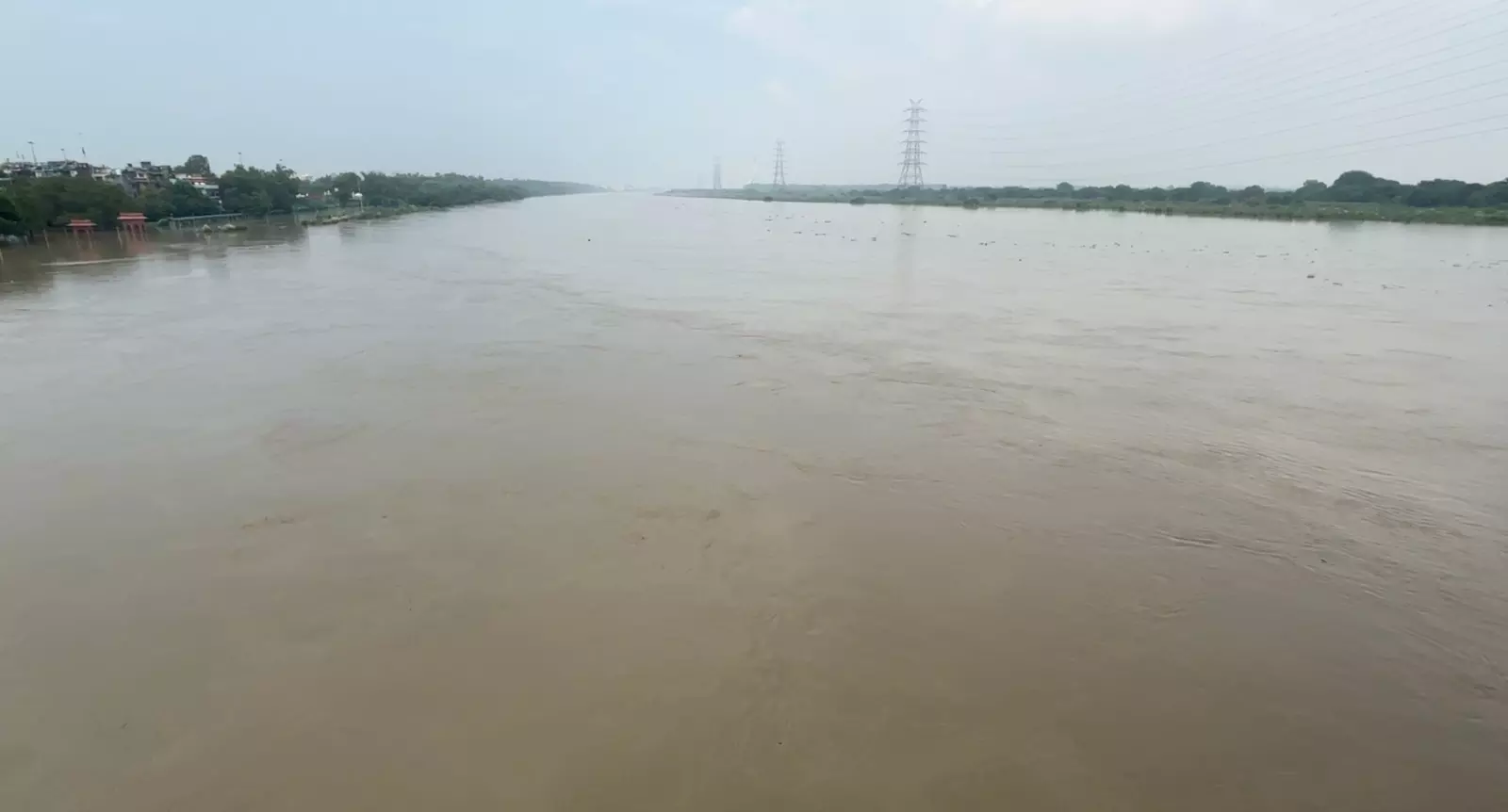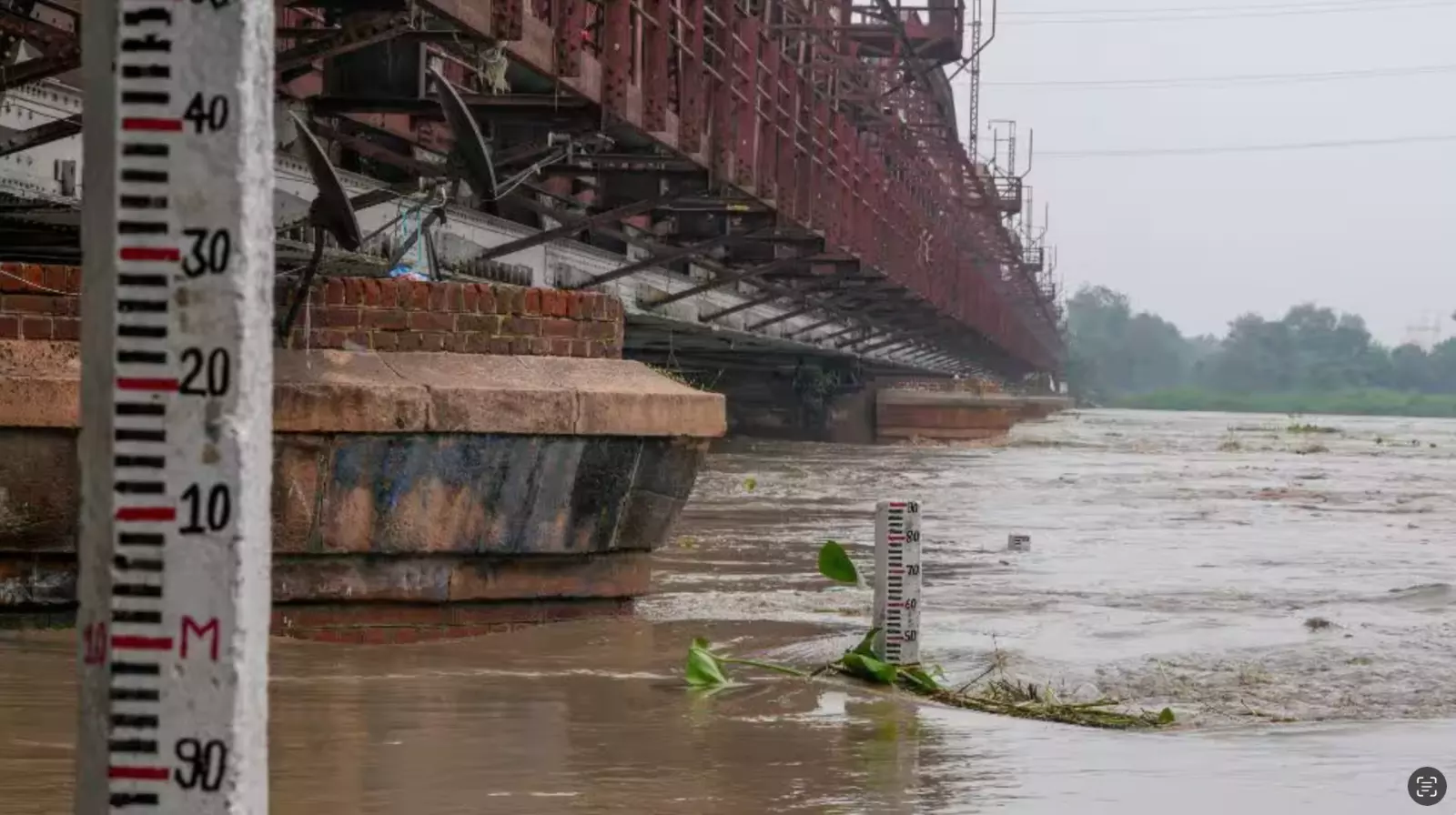
- Home
- India
- World
- Premium
- THE FEDERAL SPECIAL
- Analysis
- States
- Perspective
- Videos
- Sports
- Education
- Entertainment
- Elections
- Features
- Health
- Business
- Series
- In memoriam: Sheikh Mujibur Rahman
- Bishnoi's Men
- NEET TANGLE
- Economy Series
- Earth Day
- Kashmir’s Frozen Turbulence
- India@75
- The legend of Ramjanmabhoomi
- Liberalisation@30
- How to tame a dragon
- Celebrating biodiversity
- Farm Matters
- 50 days of solitude
- Bringing Migrants Home
- Budget 2020
- Jharkhand Votes
- The Federal Investigates
- The Federal Impact
- Vanishing Sand
- Gandhi @ 150
- Andhra Today
- Field report
- Operation Gulmarg
- Pandemic @1 Mn in India
- The Federal Year-End
- The Zero Year
- Science
- Brand studio
- Newsletter
- Elections 2024
- Events
How encroachment turns Yamuna floods into Delhi’s cycle of displacement
Come monsoon, the rising water level of the river becomes the oft-cited cause of displacement for those living on its floodplains. But can 'Yamuna Maiyya', choked to a trickle in Delhi for most of the year, be censured for reclaiming its rightful territory?

In what brought back horrifying memories of the 2023 floods in Delhi, the Yamuna water started rising again earlier this month, crossing the danger mark, following incessant rains in the national capital. The river is said to have reached the warning mark in Delhi when the water level is 204.5 metres; at 205.33 metres it touches the danger mark. According to a report of the South Asia Network...
In what brought back horrifying memories of the 2023 floods in Delhi, the Yamuna water started rising again earlier this month, crossing the danger mark, following incessant rains in the national capital. The river is said to have reached the warning mark in Delhi when the water level is 204.5 metres; at 205.33 metres it touches the danger mark. According to a report of the South Asia Network on Dams, Rivers and People (SANDRP), the scale of the Yamuna flood volume this month was lower than the flood in the upper segment of the river in 2023. But technicalities are a cold comfort to those living on the low-lying floodplains of the river, who are routinely displaced every time the Yamuna water breaches the safety levels.
Shopkeepers of Monastery Market, situated right on the Yamuna riverbank near Delhi’s iconic Kashmere Gate, and residents of nearby areas, lament that they face displacement almost every other year, owing to the flooding in the Yamuna.
“Almost every two-three years, the Yamuna’s waters come in and we are forced to leave our homes. The water does not come directly from the Yamuna but floods in when the sewers overflow. This time, the water rose about five to six feet high; in 2023, it had crossed ten feet. There is no alert from the government,” Angmo Angom, who lives in the Tibetan settlement next to the market and runs a home-office for tourists, claimed.

Water near the Buddha temple in Monastery Market. Photo by Nadim Ahmad
About a hundred metres away, under the city’s Shahdara flyover near the Chandgi Ram Akhara traffic light, is a gaushala (cow shelter) run by Baba Inder Singh. His experience of the floods was similar to Angom’s: “This time too, our gaushala was badly hit. Nearly 200 to 250 cows had to be moved out. It takes time for the water to recede and longer still to dry. From the government, no real help arrives. In the end, not only humans but even these animals become displaced,” he said.
Also read: Samudaya at 50: Why Karnataka’s theatre collective must reinvent to stay relevant
For years, the Yamuna in Delhi has been reduced to a trickle, its flow checked by the Wazirabad barrage (the first one on the river after it enters Delhi). Come monsoon, the river regains some of its glory, as the Hathni Kund Barrage in Haryana starts releasing water in the Yamuna. Interestingly though, the flooding in the Yamuna can, on most occasions, hardly be equated with the kinds of floods seen in recent weeks in Punjab or Kashmir. This is because even in its fury, the Yamuna hardly breaches its floodplains, say experts.
The displacement of human life — an estimated fifteen-twenty thousand people are forced to abandon their homes for a few months in the event of a flood — is a result of settlements having sprung up on the Yamuna khadar (meaning floodplains or wetlands). The residents of these settlements live in slums and eke out a living farming vegetables on the floodplains or as daily wage labourers. When the river reclaims her territory, they are forced to take shelter on the embankments, areas that are on higher ground, or in relief camps set up by the government.
Krishna, a resident of Sonia Vihar’s Yamuna khadar alleged, however, “The government, in the name of relief, gives us nothing more than token gestures. As soon as panic spreads, they distribute food, but the moment the water recedes, all help is withdrawn. Until the water dries, we stay on the embankment putting up our own makeshift shelters. The damage to our crops [her family grows crops on the floodplains] is another story.”
In Mayur Vihar’s Yamuna khadar, resident Ram Ladhate says there were nearly 5,000 voters in the settlement, and a great many huts. “In the monsoon, when the Yamuna rises, water inevitably comes in. We have to leave our huts, our crops are ruined,” he lamented.
While such human suffering cannot but trigger sympathy, the issue of displacement of the khadar residents is a complex one for the Delhi government. A senior Delhi government official, speaking on condition of anonymity, claimed that the population of khadar residents swells every year ahead of the monsoon, in expectation of government compensation in the event of a flood. “Any help that is extended is on a purely humanitarian ground, as all the slum colonies on the khadar are unauthorised and the land belongs to the Delhi Development Authority (DDA),” the official added.
Also read: Karnataka SC quota: Why nomadic communities feel let down by Siddaramaiah govt
Bhim Singh Rawat, an environmental expert associated with SNDRP, told The Federal that the Yamuna had a “total floodplain area of about 9,700 hectares [in Delhi]. Of this, more than 1500 hectares have been encroached.” He added: “Permanent construction is prohibited in the khadar region for the benefit of the Yamuna. But despite this, construction work has happened.”

The swollen river at the city's Kashmere Gate area. Photo by Nadim Ahmad
According to experts, construction work along the Yamuna bank is a serious cause of concern. SNDRP in a report earlier this month highlighted that “a huge part of the floodplains in Delhi has been lost to big construction and road widening projects. Most of the floodplain land on the western bank has already been permanently occupied by several governmental projects. Since the eastern floodplain of the river is lower, it is quite vulnerable to severe submergence during periodical floods. This part of the floodplain is required to allow the spread and absorption of flood water. However, over the past one-and-half decades, a huge chunk of the eastern floodplain has also been reclaimed for construction projects. The Metro Depots, CWG Village, Akshardham Temple have alone eaten into over 250 ha of the floodplain on the eastern bank.”
The report added: The “dumping of construction materials, solid waste, illegal construction on the floodplains has been taking place all over the floodplain area”.
Veteran journalist Rameshwar Dayal, whose family has resided in Delhi for generations, recalled that “until the 1980s, or even into the early ’90s, the Yamuna in Delhi was still a [regular] river. In Delhi, it runs in two stretches—25 kilometres from Palla to Wazirabad barrage, then another 25 from Wazirabad to Jaitpur. After Wazirabad, it becomes polluted because nearly 22 drains empty into it.”
He added: “In my childhood, the Yamuna was alive. We used to go to her banks to catch fish. When the Yamuna rose in flood, children and adults would go to bathe. When the waters fell, the pits left behind would fill with water, and there we caught fish. There were fairs on the riverbanks.”
Also read: As house sparrows vanish, how people across cities fight to bring them back
For years now, however, the Yamuna has only been a subject of concern in Delhi. If it is not the flooding, it is the pollution. Every autumn, as the devout gather at its bank to celebrate the Hindu festival of chhath, photographs of its dark, frothing water are splashed across newspapers.

River water at Loha Pul or the Old Iron Bridge. Photo by Nadim Ahmad
Despite repeated claims by governments formed by parties across the political spectrum of reviving the river, the Yamuna remains a sorry sight.
“The latest Delhi Pollution Control Committee (DPCC) report stated that 14 sewage treatment plants in Delhi are still not meeting faecal coliform standards — meaning untreated or inadequately treated wastewater continues to pollute the Yamuna,” Avli Verma, a researcher at the Delhi-based Manthan Adhyayan Kendra, which works on analysing and monitoring water and energy issues.
Verma added: “While a lot of attention has gone to the Ganga, critical steps for the Yamuna are still pending. An online monitoring system — essential for tracking real-time pollution levels in both the river and major drains — is still under tender, with bids invited only in August. Without reliable data, effective intervention is nearly impossible. Meanwhile, as floodwaters begin to recede, layers of silt left behind — potentially laced with contaminants — pose a serious health risk, especially to the most vulnerable communities living in low-lying areas.”
For many Indians, the Yamuna’s significance is steeped in mythology. According to Hindu beliefs, Yamuna is the daughter of the Sun God, the sister of Yama — the God of Death — and of Shani, the stern, justice-loving planet-lord. She is also regarded as the beloved queen of Krishna, the eighth incarnation of Vishnu. Some believe that Krishna and Yamuna were married near Nigambodh Ghat in Delhi, endearing the river to the residents.
In recent years, the Bharatiya Janata Party (BJP) has often touched upon the river’s iconic status. It also promised a total restoration of the river, with a dedicated Yamuna fund, ahead of this year’s assembly election in Delhi. While Prime Minister Narendra Modi, in a speech following the party’s victory in the polls, raised the slogan of “Yamuna Maiyya Ki Jai”, L-G Vinai Kumar Saxena, attributed the incumbent Aam Aadmi Party’s loss to the “curse of Yamuna Maiyya” for allegedly ignoring the condition of the river.
Beyond such rhetoric, however, what the river needs is a clear river management plan.
“In many previous studies and reports, it has been emphasised that environmental flow (E-flow) in Yamuna has reduced considerably. In such a situation, it has become necessary that the new government takes concrete steps towards restoring the natural flow of water in Yamuna. This can become the basis for the revival of Yamuna,” said Rawat.
He added: “We suggest that the floodplain on both sides of the river should remain natural, there should be no human intervention there. Natural vegetation grows in the silt, which fights the flood.”
Days after the BJP’s victory in the Delhi elections, a Yamuna clean-up drive was launched. There have since been reports of a Centre-led coordinated initiative to revitalise the river and the Delhi government seeking corporate participation in meeting the city’s environmental challenges, among them the Yamuna issue. The retreating monsoon will soon see the Yamuna shrink again to its restricted self. Will a year change the fate of the river and the residents on its floodplains, or will 2026 see another 'flood', another debate, as the Yamuna in its momentary fury sweeps a city off its complacency?
